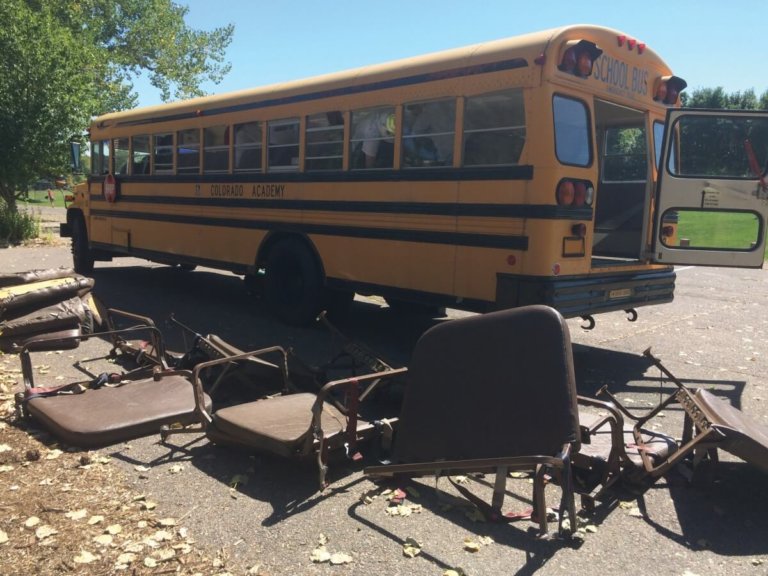A longtime CA faculty member once told teacher Katy Hills, “We can be the school with the best ideas, but that doesn’t matter until we execute those ideas.” This Upper School Studio Arts teacher peers over a computer as she recalls that advice. At her feet is a poster board, drawn out with the skeleton of a school bus. Beside her, Upper School Science teacher Chris Roads listens while collaborating on a Google Doc.
The two teachers are working together on the newest class at CA called Innovations: Tiny House. The assignment? To marry science, technology, engineering, art, and math – otherwise known as STEAM – in order to retrofit an old CA school bus into a tiny house thoughtfully designed by students.
Junior Arianna Goldman is one of those students, and she says that “Tiny House” is no traditional class. “It’s really team-based, and we collaborate with teachers to problem solve. There has been a lot of experimentation as we’ve begun the process.”
“The class promises to present myriad real-world problems to solve and opportunities to cultivate a deeper understanding of how we live now and how we might meet our human needs in the future.”
The class is organized to emphasize the exploration of ideas and follows the structure of the Design Thinking process. That process begins with empathy, or learning about the audience for whom you’re designing, followed by ideating, prototyping, and testing.
Like other students, Arianna interviewed teachers from all divisions at CA during the empathy stage, asking what they would look for in a mobile tiny home. Teachers said things like, “the ability to travel,” and “sustainability.” These common themes were tallied on a white board during the ideate phase, and then students refined their design ideas to reflect their clients’ input.
“So, where at one point we had students who wanted to make beds from hammocks, the group came together and discussed the reality of their comfort, and changed the plans to accommodate more practical bunks,” says Hills.
The result? Students have designed a bus that has an open floor plan, lined with benches that double as beds. The galley kitchen, located in the middle of the bus, will feature an energy efficient DC refrigerator, cabinets and a full propane stove and cook top. On the opposite wall, there will be a table that doubles as a desk. From there, you enter the bedroom, where sets of bunk beds will line the lengths of both walls. At the end of the bus, there will be a toilet and storage closet that doubles as a shower. The layout will continue to the roof where the bus will have a rooftop deck for luggage and gear storage. Altogether, the tiny house interior will comfortably sleep eight people.
In order to organize the workload, the students have opted into teams to handle lighting, safety, framing, and demolition. A few of those students, such as Arianna, have been selected as project managers.
 “I chose to work on the Systems Team, which is figuring out how the plumbing and electricity are going to run throughout the house, because I’m interested in design and functionality,” says Arianna. Helping her and other leaders manage their team is the project-management software called Trello. The software organizes teams by members, current and completed projects, and resources. Students can collaborate in class and remotely via Trello to update all aspects of their project at any time.
“I chose to work on the Systems Team, which is figuring out how the plumbing and electricity are going to run throughout the house, because I’m interested in design and functionality,” says Arianna. Helping her and other leaders manage their team is the project-management software called Trello. The software organizes teams by members, current and completed projects, and resources. Students can collaborate in class and remotely via Trello to update all aspects of their project at any time.
But right now, the work is on the ground and the din of drills fills the air as students complete the demolition phase. Simultaneously, they are examining bigger questions inspired by the tiny house movement. Questions like: What do we really need to live comfortably? How can we have more freedom and energy in our lives? And how can we live more efficiently?
The exploration of efficiency and sustainability is a big draw for the students, many of whom name it as their reason for joining the class. This exploration involves analyzing the expected electricity load and designing an off-grid photovoltaic system to provide all of its electrical power. A tankless propane water heater will heat water for the shower and sinks, and a composting toilet will eliminate the need for blackwater tanks and sewage dumps.
Collaborating with their peers, students have researched all aspects of the process, including the compliance issues that come into play when converting a bus into a tiny home. While they don’t yet know what color the bus will be, they do know that it won’t be yellow. “That way, it won’t need to adhere to the same restrictions as a school bus,” says Roads.
After demolition, the students will focus on cleaning the bus, treating rust and drawing electricity and plumbing plans before moving on to construction. Much in line with the collaborative nature of the class, students will be graded by peer evaluation. Altogether, they will spend about nine months working on the bus. In that time, they will have the rare opportunity to develop and oversee a large, complex project where the design limitations serve also as a spur to creativity.
“The class promises to present myriad real-world problems to solve and opportunities to cultivate a deeper understanding of how we live now and how we might meet our human needs in the future,” says Roads.
